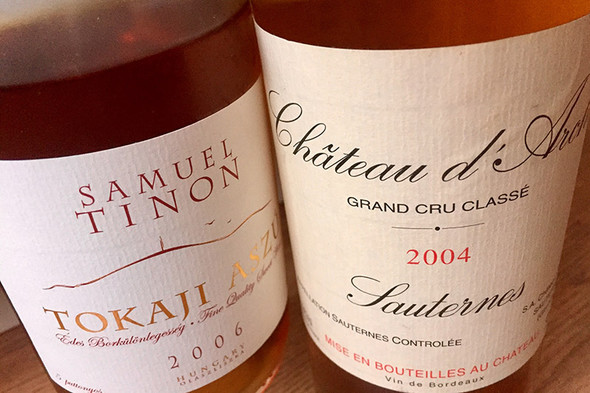There are those who have the means to put a Yquem down next to a Szepsy, but the average wine drinker most certainly doesn’t start his day like this. It wasn’t entirely clear to me either that this would turn into a short piece for WineSofa, although I have been talking around these two bottles for some time now.
Then one Sunday, the pastor came to lunch at our place. He’s a young man who climbs mountains and speeds along on his mountain bike in his free time, and now it also came to light that he enjoys sipping wine outside mass too. I happily opened bottle after bottle, until finally – instead of dessert - we came to the sweet wines.
Then I recalled that a year ago I had stumbled upon a bottle of Sauternes in a Budapest Lidl (no, really!), so I quickly scouted it out and opened it.
Chateau d’Arche, Sauternes Grand Cru Classé 2004 I 87 points
Discrete scent of honey, beeswax, peach, pineapple and barrel spices à la français. Medium bodied on the palate, the alcohol is noticeably higher than in the Tokaji wines, thereby much more ‘wine-like’ overall. The acidity is a little flabby, although well balanced. Interestingly, it’s not the acidity which balances the acidity but rather the alcohol. Medium finish with perhaps just a note of bitterness.
Whilst we were sipping this wine, I couldn’t resist getting caught up in a long – and perhaps a little boring – summary about Sauternes and Tokaj. Father István simply nodded, humphed and sipped his wine. Then it suddenly dawned on me – as that’s what we should have started with! And I went and fished a bottle of Tokaji out of the cellar. Why explain it if you can taste it instead?
Samuel Tinon, Tokaji Aszú 5p 2006 I 95 points
Extremely intense nose in which citrus fruit is still present but no long playing the leading role. There is also a touch of propolis, a hint of walnut, lychee and mango, plenty of apricot, a little rosehip and a pinch of tobacco. Medium to full bodied on the palate with fiery acidity. There is a kind of vibrant tension in the wine, making the whole experience incredibly intense. The aromas on the nose are echoed on the palate, extremely well balanced, with an almost infinite finish. Harmonic, great wine, far from mainstream Tokaji Aszú.
The real journalistic trick would now be if I told you that the priest then only asked for more Aszú. And it would be true, because so it was. Whereas something else came to my mind. On the one hand, we compare the two wine regions with each other only for the sake of simplification; on the other, they represent completely different styles. From this perspective, it’s not entirely fair to taste them together, because such a good Aszú has a good chance of wiping the floor with a significant percentage of Sauternes wines. However, what is even more interesting is that the Tinon family owns an estate right next to Sauternes where they also produce naturally sweet wine. Samuel however lives in Olaszliszka in the Tokaj wine region. If nothing else, it’s worth giving this some thought…






